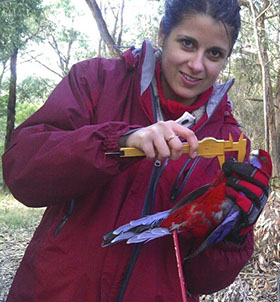Birds of a smelly feather stick together
Media releaseRaucous, gorgeous crimson rosellas are able to sniff out their own species by the lingering odour left over from smelly feathers, unique research by Deakin University has found.
In the first study to definitively delve in to the olfactory senses of the beautiful Australian birds, Centre for Integrative Ecology (CIE) researchers have discovered that crimson rosellas rely not just on sight but also their sense of smell to communicate.
CIE PhD student Milla Mihailova led the project and said the stunningly unexpected findings are an indication that birds' olfactory senses may play a larger role in ecology and evolution than previously thought.
"It has always been said that birds had no sense of smell but these findings indicate that they rely on their olfactory senses to communicate with one another and possibly even choose mates," Ms Mihailova said.
"There has been a traditional notion that birds have little or no sense of smell because there has been so little research in to the area and also, unlike other animals including dogs and cats, we don't see birds actually sniffing things."
Ms Mihailova said her research showed female crimson rosellas preferred to sit on their eggs in nest boxes that had the odour of another rosella - and that they also favoured boxes that smelt like a male rosella.
Ms Mihailova said the results of the research partly could help explain why rosellas – the vividly plumed flying Australian icons – smell so strongly.
"When we work with them, we have to spend a lot of time washing the smell of them off our hands because the rosellas have a very robust odour," she said.
"Even birds that have been dead for more than 30 years but are kept as curios in museums retain their very strong scent."
Ms Mihailova and her team studied the behaviour of female crimson rosellas (Platycercus elegans) brooding in nest boxes at Bellbrae and Steiglitz in Victoria over two breeding seasons from 2011 to 2013.
The researchers set out specifically to test if female crimson rosellas could discern the distinctive odour of their own subspecies and whether they could also spot a difference between the sexes.
After more than two years' of study, they found that the females preferred going to nest boxes that carried the waft of a male over the smell of another female.
"I think the fact that a bird can sniff out its own subspecies, species and the sexes, is amazing.
"The preference of female crimson rosellas to spend more time in and on a nesting box that smells more of a male suggests it may play a role in in sexual selection for this species.
"Also, we found that birds could discriminate subspecies based on their odour alone, so subspecies divergence and maintenance may be explained by smell."
Her report, "Odour-based discrimination of subspecies, species and sexes in an avian species complex, the crimson rosella" has been published in the journal Animal Behaviour and in Australian Geographic online.
Crimson rosellas are Australian parrots that occur through eastern and south eastern Australia and often seen and heard riotously feasting on flowers, nuts and seeds found in many suburban parks and gardens.
The crimson rosella is one common subspecies. Two other subspecies are the Adelaide rosella, common in the Adelaide and the Adelaide Hills, and the yellow rosella found along the Murray and Murrumbidgee rivers.
Share this story
 Milla Mihailova measures a rosella
Milla Mihailova measures a rosella
